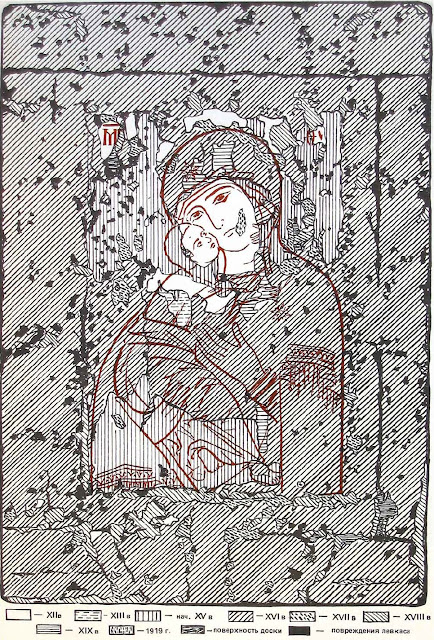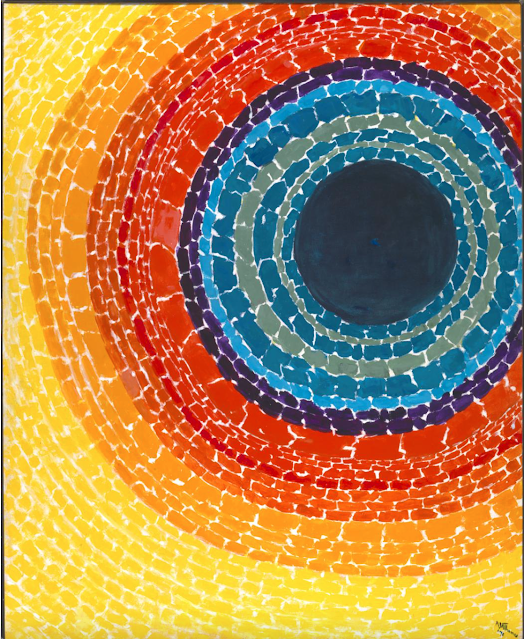Saturday, February 26, 2022
The Virgin of Vladimir
Friday, February 25, 2022
Hagia Sophia in Kyiv
The elaborate Baroque exterior of the Cathedral of Hagia Sophia in Kyiv conceals a well preserved Byzantine church from the 11th century, among the oldest churches in the Slavic world. Byzantine artists and craftsmen from Constantinople built the cathedral as the crowning monument of a campaign by the Orthodox church to evangelize the Slavic peoples in what would eventually be Kievan Rus followed by Ukraine, Russia, and Belarus.
Some of the original 11th century brickwork made visible on the Cathedral's exterior.
A model of the original 11th century cathedral concealed by additions from the 17th and 18th centuries.
The interior of the Cathedral little changed since the 11th century. Most of the mosaics are 11th century originals.
Christ Pantocrator in the dome with four archangels.
The Virgin Orans in the half-dome of the apse.
Various fathers of the church.
So far as I know, no provision was made to spare or protect this church from the fighting currently going on in Kyiv. It will eventually pass again into Russian ownership. This building saw many sieges and invasions over the centuries from Mongols to Tatars to Tamerlane to Stalin, to Hitler, and now to Putin. In the midst of what historian Timothy Snyder calls the Bloodlands sandwiched between the ambitions of the 20th century's two worst tyrants stands ancient Hagia Sophia, a durable testament to the hope of a glorious fulfillment at the end of a long and dark history.
Liberal Democracy
Liberal Democracy has been out of fashion for a long time, and now it's under attack. It lost its academic respectability long before Jacques Derrida demolished its foundations. It's not freedom that's enjoying a rebirth these days, but despotism. Leading that movement is Russia's brutal and determined dictator Vladimir Putin followed by China's Xi Jinping. Around the world there is a host of Putin wannabees; Brazil's Bolsonaro, India's Modi, Hungary's Orban, Turkey's Erdogan, Philippines' Duterte, and of course, the USA's Trump. It's been nearly a century since tyranny looked so cutting edge. Hip but over-cautious journalists coined a new euphemism for dictatorship calling it "illiberal democracy," as though genuine democracy could be anything but liberal.
Historians point out that far from new, despotism has been with us since before the beginning of history universally in all parts of the world. It's liberal democracy that's the real novelty, a fragile thing with feathers jerry-built by quarreling committees and only around since the 18th century.
Fragile despised thing that liberal democracy is, people still vote for it with their feet in big numbers. We can watch it happening now on the news. Droves of people will risk their lives for a little vulgar prosperity and a chance to make their own lives as they see fit. They'll take discount stores and do-it-yourself over any despot's dreams of glory, or any philosopher's vision of the celestial Jerusalem every time. They want prosperity, but they want freedom and dignity as well, something no tyrant will give his people no matter how well he can deliver a consumer economy to them.
And now we watch Vladimir Putin destroy Ukraine and create grief and misery for millions of people in the name of geo-political strategy. Those among us who want tribal supremacy over democracy cheer him on. They want to build a white man's Valhalla on the ashes of E Pluribus Unum, and they're willing to kill for it. Freedom for Me Alone! Everyone else can stay in their chains.
We are at a moment of decision where those of us who live under liberal democracy must believe that it is worth fighting for abroad and at home.
I answer for myself an emphatic YES!
Below is a symbol I post frequently on my Facebook page that means a lot to me. It's the emblem of the Double Victory movement during the Second World War. It was a movement of Black American soldiers who wanted to link the fight against fascism abroad with the struggle against segregation at home. Freedom abroad only means anything if there's freedom at home for everybody. No one is really free separately, but we can all be free together. "Unless I'm free, you're not free," said Mary Lou Hamer. That goes up and down all around our community.
And now we face that moment of decision, whether or not we are willing to fight for democracy on other continents and right here in the neighborhood. The best of all possible worlds is one where our freedom and happiness no longer depend on other people's misery, but on their freedom and happiness too.
Ukraine
Yesterday in Times Square. A photo posted on Facebook by the Veselka Restaurant, a Ukrainian restaurant that has long been an institution in the East Village. I ate there many times when I lived in that neighborhood. There was and still is a large Ukrainian population in the East Village, big enough to have their own churches, their own school, and their own social center. There's a big Ukrainian population in the New York area and in New Jersey.
They are really hurting right now, and we are hurting right along with them.
Friday, February 4, 2022
Alma Thomas
Alma Thomas was born in Columbus, Georgia into an upper-middle class family in 1891. Her family moved to Washington DC in 1907 fleeing a wave of racist violence in Georgia. Though Washington was a segregated city, it had more opportunities for African Americans than most of the rest of the South did. Her family bought a house in the Logan Circle neighborhood of Washington. Alma Thomas lived in that house for the rest of her life until she died in 1978.
Wednesday, February 2, 2022
James Bidgood
Before there was Pierre et Gilles, before there was David LaChapelle, before there was Cindy Sherman, there was James Bidgood with his camera working in a tiny New York apartment.
James Bidgood died January 31 at the age of 88.
Bidgood's 1971 movie Pink Narcisssus that took him seven years to make starring Bobby Kendall. Bidgood built all the sets, made all the costumes, figured out all the lighting and special effects. He filmed all of it in a tiny 14th Street railroad flat.
YouTube pulled Bidgood's Pink Narcissus for a bunch of reasons including copyright conflicts.
So, here are some stills from the movie.
















































